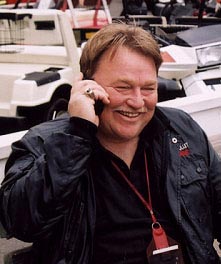|


6/23/04
Cost of racing NHRA Pro Stock
is going up!

 he
NHRA professional classes of Pro Stock and Pro Stock Bike
have always had plenty of entries at national events. Too
many, some would say. But, the fact remains that both of
those classes are relatively affordable compared to Top
Fuel or Funny Car and, because of that, Pro Stock hasn't
suffered the short field malady that the nitro fields have
in the past decade or so. he
NHRA professional classes of Pro Stock and Pro Stock Bike
have always had plenty of entries at national events. Too
many, some would say. But, the fact remains that both of
those classes are relatively affordable compared to Top
Fuel or Funny Car and, because of that, Pro Stock hasn't
suffered the short field malady that the nitro fields have
in the past decade or so.
Fielding a competitive or even a semi-competitive nitro team has become
so expensive that filling a 16-car field in either category isn't
guaranteed. It simply takes too much money, equipment and crew. A few
diehards still occasionally enter a competitive Top Fuel car or flopper
team for one or two events, but even that is becoming a rarity in those
classes now and probably soon will be in Pro Stock.
Up to now the Pro Stock class hasn't had those problems. Don't
misunderstand me, a Pro Stock car isn't cheap, but it has been an
affordable professional class compared to Top Fuel or Funny Car. A
part-time Pro Stock racer could buy or rent an engine, buy or lease a
roller from someone and get to the track with a competitive combination
for under $250,000 with a good chance of qualifying.
I think that scenario in Pro Stock is about to become just a fond
memory. Let me tell you why. First, Greg Anderson brought NASCAR engine
specialist Jason Line into his Pro Stock program. Line had connections
and experience with the Joe Gibbs NASCAR organization and brought that
experience and technology with him. He also is a very good driver.
Second, the news that Barry Grant is building a 10,000 square foot
NASCAR-style engine shop in the Charlotte area comes across the wire
and I'm told that some personnel -- supposedly engine specialists --
from Dale Earnhardt Incorporated will be or are already building
engines for Barry Grant.
Finally, on June 18, 2004 Don Schumacher stepped up and bought the
Larry Morgan Mopar-backed Pro Stock team. He also hired Bob Glidden to
manage the team and build the engines.
It doesn't take a Kreskin to see what's about to happening in Pro
Stock. The initiation fee to join the Pro Stock club is going up, way
up, if you want to be competitive. I believe the days of small shops
and one-man engine programs are numbered. Ten thousand-square foot
engine shops with 10-20 employees are going to become the rule not the
exception. Single-car teams will have even more difficulty qualifying
than they do now (much less winning), forcing owners of single car
teams such as Reher-Morrison, the Connollys, Jim Yates and Dick Maskin
to invest in second cars if they want to remain competitive with the
Andersons, Johnsons, Schumachers and Coughlins.
And, I think the days of leasing a truly competitive engine from teams
is probably history. Successful teams probably won't spend the money to
develop an engine program and then give it to someone who might have a
chance of beating them -- unless that someone is willing to take a
"dive" should the need arise.
Remember the glory days of Mopar Pro Stock when anywhere from four to
six teams had direct factory support? Mopar supposedly gave engine
builder and team owner David Nickens $1,000,000 for an engine program
for the factory teams. Those engines weren't for sale or rent.
My point here is that Pro Stock, a class that for the last couple of
decades appeared to be a hobby for rich guys and a profession for a
few, is at a crossroads. Serious drivers and team owners such as Greg
Anderson, Barry Grant, Jeg Coughlin Sr. and Don Schumacher are going to
take the class from an expensive racing hobby and make it a class that
mimics NASCAR's Cup Series.
Just as the well-funded teams such as DEI, Jack Rousch, and others
drove privateers like Junie Donleavy and his ilk out of NASCAR, so the
Andersons, Coughlins, Schumachers, and Johnsons will drive away the
Rickie Smiths of NHRA Pro Stock.
At the last two NHRA events, Columbus and E-town, there were just 25
cars total entered in Pro Stock. That number represents the lowest car
count I can remember in recent Pro Stock history. Not incidentally, 25
is about the max number of entries for any fuel class in the last
decade for so.
Just as we will probably never see 32-car entry lists for either nitro
classes again, I also believe that with a very few exceptions -- the
U.S. Nationals being one -- we won't see 35-40 cars qualifying for 16
spots in Pro Stock. Fans should face the fact that, just as in the Top
Fuel and Fuel Coupe classes, they will have to be happy with fewer, but
technologically better, Pro Stockers.
As I've said many times recently, today's professional drag racing
isn't your daddy's professional drag racing, and eventually everything
comes down to the "Benjamins."
We'd all better get used to it because the sport of drag racing almost
never slows down or backs up, no matter how hard anyone tries or how
much they would like it to.

|